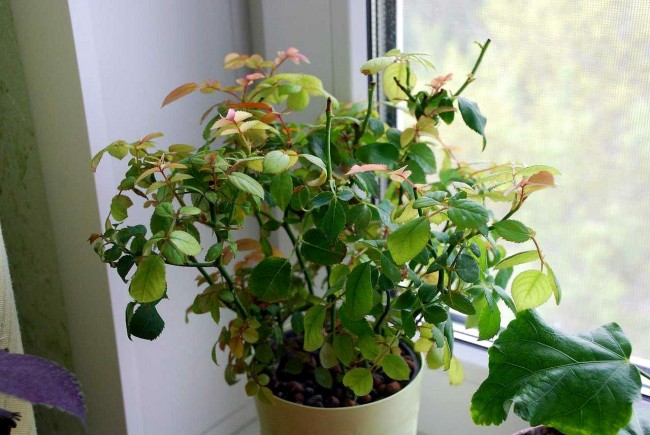Content:
A beautiful flower is a great addition to any decor. The most famous varieties of indoor roses are hybrid tea, polyanthus and remontant. They are all very similar to each other. For keeping roses at home, plants grown from cuttings are the best option. The grafted flowers are poorly preserved indoors. Also, after acquiring a bush you like, you should not transplant it immediately. Instead, it is recommended to place the flower on a window facing east or southeast so that the rose gets used to the local microclimate.
Which pot to choose
Indoor roses are sold in containers, so choosing the right container will not be difficult.
A flower pot must have the following parameters:
- the diameter must be at least 2 cm larger than the diameter of the container in which the flower was sold;
- the height should exceed the height of the container by 5-7 cm.
A pot for planting roses is preferable wooden or ceramic. You can use plastic ones, but the soil dries faster in them, and the flowers will suddenly wither. Clay pots are not recommended as they absorb water.
How to transplant a rose purchased at a flower shop into a pot:
- Water the rose beforehand (20 minutes before transplanting).
- Cover the bottom of the pot with a layer of drainage, the thickness of which should be approximately 1 cm.In the case when there is no drain hole in the pot, the drainage layer should be made more than 3 cm.
- Next, add a mixture of soil and fertilizer.
- While holding the plant, turn the container over and shake it a little.
- Set the roots with soil in a pot, sprinkling a new layer of earth on top, gradually compacting it so that the indent from the edge of the pot is 2-3 cm.
- Sprinkle foliage.
- Place the flower pot in the shade.
- After 24 hours, move the flower to a sunny place.
Rose in a pot: home care after purchase
You can revive the presented flower by cutting cuttings. To do this, you need to do the following:
- Cut the cuttings from the almost withered flower. Their length should be in the range from 10 to 15 cm. The cuttings should have at least 3 buds.
- With a sharp knife, make an oblique cut 5 cm under the internode.
- Remove the lower leaves, and leave half of the upper ones.
- Place the cuttings in a root or heteroauxin solution for 12-14 hours.
- Prepare a small pot of loose soil.
- Plant the stalk in the soil at a slight slope and compact the soil around the stalk.
- Water the cutting abundantly and wrap it in a plastic bag on top to create a microclimate that has a beneficial effect on the rooting of the flower.
- Spray the cutting 3 times a day, making sure that the soil is constantly slightly damp.
If this algorithm is followed correctly, over time, the cutting should take root and bloom.
Homemade rose in a pot: how to care
How to properly water potted roses:
- watering should be done exclusively with settled water as the soil dries out;
- it should be watered at the root and at the least sultry time of the day;
- overheating of the flower is contraindicated.
The rules for caring for potted roses by their principle do not differ much from the rules for caring for rose bushes. After 30 days, with the onset of the active growing season, the plant needs feeding. It is worth feeding a flower once every 14 days, spraying the foliage with a weak solution of special fertilizers or treating it with a mullein solution, mineral fertilizers. This should be done after watering in the evening.
The principle of caring for roses depends on the season. How to care for a rose in a pot at home in a given season.
Summer
During this period, abundant watering, spraying, feeding and removal of wilted flowers are carried out. It is also important to prevent the rose from overheating and showing signs of disease. If the light constantly falls on the bush from the same side, then you need to periodically rotate the flower so that the bush develops evenly.
Fall
After the temperature drops below 12 ° C, it is recommended to place the rose on the south window. As soon as the rose has stopped producing buds, watering should be reduced, leaving the soil dry for 1-2 days, and also stop feeding the plant. It is undesirable to leave heating and electrical household appliances in the vicinity of the plant. To prepare a bush for wintering, you need to cut it off, leaving 5 living buds on a branch. Do not remove foliage. This action must be performed during the growth phase of the moon.
Winter
During frosts, there is a break in flowering, and the bush is freed from foliage. Watering and spraying in winter should be done less frequently than in other seasons (after the soil dries out in 2-3 days). In apartments where central heating is installed, a container with wet pebbles or gravel should be placed under a pot of roses, maintaining their constant humidity.
Spring
The break between watering procedures is no more than one day from the moment the soil dries. As soon as buds begin to appear, then you need to feed with mineral fertilizers or a solution of chicken manure. Fertilizing roses should be done after watering 1 time in 7 days. At the stage of budding, the flower must be given the opportunity to stay in the sun and water it systematically. At the onset of spring warmth, the rose can be transferred to the balcony or garden, because thanks to this, it gets used to the bright sun. First you need to put in the shade, then, after 2 weeks, in a bright place.
Reasons for drying out potted roses
Possible reasons for the drying out of indoor roses and leaf fall can be:
- care errors;
- acclimatization of the flower after purchase;
- the presence of pests;
- the presence of a disease.
Florist tips to fix these problems:
- The secret to plant health lies in proper care.
- When acclimatizing, it is worthwhile, properly caring for the plant, to wait a while.
- In the presence of pests, the plant must be treated with phytoverm from aphids or thrips. It also helps to get rid of spider mites (signs: thin spider webs under foliage).
The most common disease provoked by the drying of indoor roses is the process of rotting roots. The reason for this is excess moisture or very dense soil that does not have time to dry out. In this case, you need to remove the old soil, cut out the affected roots and rinse in a solution of potassium permanganate. After that, place the plant for half an hour in a fungicide solution and transplant into a fresh, loose nutrient substrate.
Thus, there is nothing difficult in growing a room rose. It will not cause trouble even for a novice florist, because everything is standard: watering, fertilizing, pruning.















